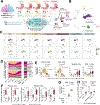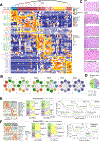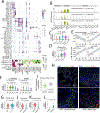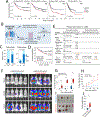Evolution of immune and stromal cell states and ecotypes during gastric adenocarcinoma progression
- PMID: 37419119
- PMCID: PMC10528152
- DOI: 10.1016/j.ccell.2023.06.005
Evolution of immune and stromal cell states and ecotypes during gastric adenocarcinoma progression
Abstract
Understanding tumor microenvironment (TME) reprogramming in gastric adenocarcinoma (GAC) progression may uncover novel therapeutic targets. Here, we performed single-cell profiling of precancerous lesions, localized and metastatic GACs, identifying alterations in TME cell states and compositions as GAC progresses. Abundant IgA+ plasma cells exist in the premalignant microenvironment, whereas immunosuppressive myeloid and stromal subsets dominate late-stage GACs. We identified six TME ecotypes (EC1-6). EC1 is exclusive to blood, while EC4, EC5, and EC2 are highly enriched in uninvolved tissues, premalignant lesions, and metastases, respectively. EC3 and EC6, two distinct ecotypes in primary GACs, associate with histopathological and genomic characteristics, and survival outcomes. Extensive stromal remodeling occurs in GAC progression. High SDC2 expression in cancer-associated fibroblasts (CAFs) is linked to aggressive phenotypes and poor survival, and SDC2 overexpression in CAFs contributes to tumor growth. Our study provides a high-resolution GAC TME atlas and underscores potential targets for further investigation.
Keywords: Cancer-associated fibroblast; Chronic Atrophic Gastritis; Ecotype; Gastric Adenocarcinoma; Immune-Stroma Crosstalk; Intestinal Metaplasia; Peritoneal Carcinomatosis; Single Cell RNA Sequencing; Syndecan 2; Tumor Microenvironment.
Copyright © 2023 Elsevier Inc. All rights reserved.
Conflict of interest statement
Declaration of interests The authors declare no competing interests.
Figures







References
-
- Tan HL, Chia CS, Tan GHC, Choo SP, Tai DWM, Chua CWL, Ng MCH, Soo KC, and Teo MCC (2019). Metastatic gastric cancer: Does the site of metastasis make a difference? Asia-Pacific Journal of Clinical Oncology 15, 10–17. - PubMed
-
- Hirao M, Yamada T, Michida T, Nishikawa K, Hamakawa T, Mita E, Mano M, and Sekimoto M (2018). Peritoneal seeding after gastric perforation during endoscopic submucosal dissection for gastric cancer. Digestive surgery 35, 457–460. - PubMed
-
- Yoshida M, Sugino T, Kusafuka K, Nakajima T, Makuuchi R, Tokunaga M, Tanizawa Y, Bando E, Kawamura T, and Terashima M (2016). Peritoneal dissemination in early gastric cancer: importance of the lymphatic route. Virchows Archiv 469, 155–161. - PubMed
Publication types
MeSH terms
Grants and funding
LinkOut - more resources
Full Text Sources
Other Literature Sources
Medical
Molecular Biology Databases
Miscellaneous

